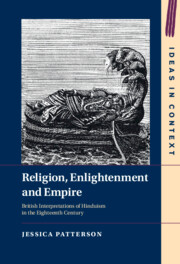33 results
Conclusion
- from Part II - From Scepticism to Orientalism
-
- Book:
- Religion, Enlightenment and Empire
- Published online:
- 09 December 2021
- Print publication:
- 16 December 2021, pp 309-319
-
- Chapter
- Export citation
Chapter 1 - European Letters, the Company and Hinduism
- from Part I - Religion, Enlightenment and Empire
-
- Book:
- Religion, Enlightenment and Empire
- Published online:
- 09 December 2021
- Print publication:
- 16 December 2021, pp 35-69
-
- Chapter
- Export citation
Introduction
-
- Book:
- Religion, Enlightenment and Empire
- Published online:
- 09 December 2021
- Print publication:
- 16 December 2021, pp 1-32
-
- Chapter
- Export citation
Bibliography
-
- Book:
- Religion, Enlightenment and Empire
- Published online:
- 09 December 2021
- Print publication:
- 16 December 2021, pp 320-350
-
- Chapter
- Export citation
Chapter 4 - Enlightenment and Empire
- from Part I - Religion, Enlightenment and Empire
-
- Book:
- Religion, Enlightenment and Empire
- Published online:
- 09 December 2021
- Print publication:
- 16 December 2021, pp 155-204
-
- Chapter
- Export citation
Index
-
- Book:
- Religion, Enlightenment and Empire
- Published online:
- 09 December 2021
- Print publication:
- 16 December 2021, pp 351-356
-
- Chapter
- Export citation
Acknowledgements
-
- Book:
- Religion, Enlightenment and Empire
- Published online:
- 09 December 2021
- Print publication:
- 16 December 2021, pp viii-ix
-
- Chapter
- Export citation
Copyright page
-
- Book:
- Religion, Enlightenment and Empire
- Published online:
- 09 December 2021
- Print publication:
- 16 December 2021, pp iv-iv
-
- Chapter
- Export citation
Chapter 6 - Charles Wilkins and the Gēētā
- from Part II - From Scepticism to Orientalism
-
- Book:
- Religion, Enlightenment and Empire
- Published online:
- 09 December 2021
- Print publication:
- 16 December 2021, pp 239-262
-
- Chapter
- Export citation
Chapter 2 - John Zephaniah Holwell and the Religion of the Gentoos
- from Part I - Religion, Enlightenment and Empire
-
- Book:
- Religion, Enlightenment and Empire
- Published online:
- 09 December 2021
- Print publication:
- 16 December 2021, pp 70-112
-
- Chapter
- Export citation
Chapter 7 - William Jones, Vedānta and the ‘Permanent Settlement’
- from Part II - From Scepticism to Orientalism
-
- Book:
- Religion, Enlightenment and Empire
- Published online:
- 09 December 2021
- Print publication:
- 16 December 2021, pp 263-308
-
- Chapter
- Export citation
Chapter 3 - Alexander Dow and the Hindoo Shasters
- from Part I - Religion, Enlightenment and Empire
-
- Book:
- Religion, Enlightenment and Empire
- Published online:
- 09 December 2021
- Print publication:
- 16 December 2021, pp 113-154
-
- Chapter
- Export citation
Part I - Religion, Enlightenment and Empire
-
- Book:
- Religion, Enlightenment and Empire
- Published online:
- 09 December 2021
- Print publication:
- 16 December 2021, pp 33-204
-
- Chapter
- Export citation
Contents
-
- Book:
- Religion, Enlightenment and Empire
- Published online:
- 09 December 2021
- Print publication:
- 16 December 2021, pp vii-vii
-
- Chapter
- Export citation
Abbreviations
-
- Book:
- Religion, Enlightenment and Empire
- Published online:
- 09 December 2021
- Print publication:
- 16 December 2021, pp xi-xii
-
- Chapter
- Export citation
A Note on the Text
-
- Book:
- Religion, Enlightenment and Empire
- Published online:
- 09 December 2021
- Print publication:
- 16 December 2021, pp x-x
-
- Chapter
- Export citation
Part II - From Scepticism to Orientalism
-
- Book:
- Religion, Enlightenment and Empire
- Published online:
- 09 December 2021
- Print publication:
- 16 December 2021, pp 205-319
-
- Chapter
- Export citation
Chapter 5 - Nathaniel Brassey Halhed and Gentoo Antiquity
- from Part II - From Scepticism to Orientalism
-
- Book:
- Religion, Enlightenment and Empire
- Published online:
- 09 December 2021
- Print publication:
- 16 December 2021, pp 207-238
-
- Chapter
- Export citation
Dedication
-
- Book:
- Religion, Enlightenment and Empire
- Published online:
- 09 December 2021
- Print publication:
- 16 December 2021, pp v-vi
-
- Chapter
- Export citation

Religion, Enlightenment and Empire
- British Interpretations of Hinduism in the Eighteenth Century
-
- Published online:
- 09 December 2021
- Print publication:
- 16 December 2021



